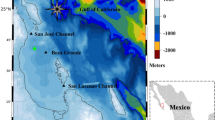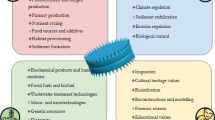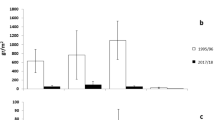Abstract
Aureococcus anophagefferens, the pelagophyte responsible for brown tide blooms, occurs in coastal bays along the northeast coast of the United States. This species was identified in Chincoteague Bay, Maryland, in 1997 and has bloomed there since at least 1998. Time series of dissolved organic matter (DOM) concentrations and characteristics are presented for two sites in Chincoteague Bay: one that experienced a brown tide bloom in 2002 and one that did not. Characteristics of the bulk DOM pool were obtained using dissolved organic carbon (DOC) and ultraviolet-visible (UV-Vis) measurements (spectral slope and specific UV absorbance). High molecular weight DOM (HMW-DOM) was characterized in terms of DOC concentration, carbon: nitrogen (C:N) ratio, isotopic signature, and molecular-level characteristics as determined by direct temperature resolved mass spectrometry (DT-MS). Compositional changes in the DOM pool are associated with brown tide blooms, although a direct relationship between DOM characteristics and bloom development could not be confirmed. DOC measurements suggest that during the brown tide bloom, HMW-DOM was released into the surface water. UV-Vis analysis on the bulk DOM and molecular-level characterization of the HMW-DOM using DT-MS show that this material was optically active and more aromatic in nature. Based upon C:N ratio and HMW-DOC measurements, it appears that this HMW-DOM was more nitrogen enriched. Whether this material was released as exudates or was due to lysis ofA. anophagefferens could not be determined.
Similar content being viewed by others
Literature Cited
Benner, R. 1991. Ultrafiltration for the concentration of bacteria, viruses, and dissolved organic matter, p. 181–186.In D. C. Hurd and D. W. Spencer (eds.), The Analysis and Characterization of Marine Particles. Geophysical Monograph 63. American Geophysical Union, Washington, D.C.
Benner, R. 2002. Chemical composition and reactivity, p. 59–90.In D. Hansell and C. Carlson (eds.), Biogeochemistry of Marine Dissolved Organic Matter. Academic Press, San Diego, California.
Benner, R., B. Biddanda, B. Black, andM. McCarthy. 1997. Abundance, size distribution, and stable carbon and nitrogen isotopic compositions of marine organic matter isolated by tangential-flow ultrafiltration.Marine Chemistry 57:243–263.
Berg, G. M., P. M. Glibert, M. W. Lomas, andM. A. Burford. 1997. Organic nitrogen uptake and growth by the chrysophyteAureococcus anophagefferens during a brown tide event.Marine Biology 129:377–387.
Berg, G. M., D. J. Repeta, andJ. LaRoche. 2003. The role of the picoeukaryoteAureococcus anophagefferens in cycling of marine high-molecular weight dissolved organic nitrogen.Limnology and Oceanography 48:1825–1830.
Blough, N. V. andR. Del Vecchio. 2002. Chromophoric DOM in the coastal environment, p. 509–546.In D. Hansell and C. Carlson (eds.), Biogeochemistry of Marine Dissolved Organic Matter. Academic Press, San Diego, California.
Boon, J. J. 1992. Analytical pyrolysis mass spectrometry: New vistas opened by temperature-resolved in-source PYMS.International Journal of Mass Spectrometry and Ion Processes 118/119:755–787.
Bricelj, V. M. andD. J. Lonsdale. 1997.Aureococcus anophagefferens: Causes and ecological consequences of brown tides in the U.S. mid-Atlantic coastal waters.Limnology and Oceanography 42:1023–1038.
Brumbauugh, R. D. 1996. Recruitment of blue crab,Callinected sapidus, postlarvae to the back-barrier lagoons of Virginia's Eastern Shore. Ph.D. Dissertation, Department of Oceanography, College of Sciences, Old Dominion University, Norfolk, Virginia.
Burdige, D. J. andJ. Homstead. 1994. Fluxes of dissolved organic carbon from Chesapeake Bay sediments.Geochimica Cosmochimica Acta 58:3407–3424.
Cerco, C. F., C. S. Fang, andA. Rosenbaum. 1978. Intensive hydrographical and water quality survey of the Chincoteague/Sinepuxent/Assawoman Bay systems, Volume III. Non-point source pollution studies in the Chincoteague Bay system. Maryland Water Resources Administration, Special scientific report No. 86. Virginia Institute of Marine Science, Gloucester Point, Virginia.
Chin, Y. P., G. Aiken, andE. O'Loughlin. 1994. Molecular weight, polydispersity, and spectroscopic properties of aquatic humic substances.Environmental Science and Technology 28:1853–1858.
Cosper, E. M., C. Lee, andE. J. Carpenter. 1990. Novel “brown tide” blooms in Long Island embayments: A search for the causes, p. 17–28.In E. Graneli, B. Sundstrom, L. Edler, and D. M. Anderson (eds.), Toxic Marine Phytoplankton: Proceedings of the Fourth International Conference on Toxic Marine Phytoplankton, Elsevier, New York.
Davis, J. C. 1986. Statistics and Data Analysis in Geology, 2nd edition. Wiley, New York.
Dillow, J. J. A., W. S. L. Banks, and M. J. Smigaj. 2002. Groundwater quality and discharge to chincoteague and Sinepuxent Bays adjacent to Assateague Island National Seashore, Maryland. U.S. Department of the Interior, U.S. Geological Survey, Water-Resources Investigations Report 02-4029. Baltimore, Maryland.
Dzurica, S., C. Lee, E. M. Cosper, andE. J. Carpenter. 1989. Role of environmental variables, specifically organic compounds and micronutrients, in the growth of the chysophyteAureococcus anophagefferens, p. 229–252.In E. M. Cosper, V. M. Bricelj, and E. J. Carpenter (eds.), Novel Phytoplankton Blooms: Causes and Impacts of Recurrent Brown Tides and Other Unusual Blooms, Volume 35. Springer-Verlag, Berlin, Germany.
Eglinton, T. I., J. J. Boon, E. C. Minor, andR. J. Olson. 1996. Microscale characterization of algal and related particulate organic matter by direct temperature-resolved mass spectrometry.Marine Chemistry 52:27–54.
Garry, R. T., P. Hearing, andE. M. Cosper. 1998. Characterization of a lytic virus infectious to the bloom-forming microalgaAureococcus anophagefferens (Pelagophyceae).Journal of Phycology 34:616–621.
Gastrich, M. D., O. R. Anderson, S. S. Benmayor, andE. M. Cosper. 1998. Ultrastructural analysis of viral infection in the brown-tide alga,Aureococcus anophagefferens (Pelagophyceae).Phycologia 37:300–306.
Glibert, P. M., R. Magnien, M. W. Lomas, J. Alexander, C. Fan, E. Haramoto, M. Trice, andT. M. Kana. 2001. Harmful algal blooms in the Chesapeake and Coastal Bays of Maryland, USA: Comparison of 1997, 1998, and 1999 events.Estuaries 24:875–883.
Gobler, C. J., D. A. Hutchins, N. S. Fisher, E. M. Cosper, andS. A. Sanudo-Wilhelmy. 1997. Release and bioavailability of C, N, P, Se, and Fe following viral lysis of a marine chrysophyte.Limnology and Oceanography 42:1492–1504.
Gobler, C. J., M. J. Renaghan, andN. J. Buck. 2002. Impacts of nutrient and grazing mortality on the abundance ofAureococcus anophagefferens during a New York brown tide bloom.Limnology and Oceanography 47:129–141.
Gobler, C. J. andS. A. Sanudo-Wilhelmy. 2001. Effects of organic carbon, organic nitrogen, inorganic nutrients, and iron additions on the growth of phytoplankton and bacteria during a brown tide bloom.Marine Ecology Progress Series 209:19–34.
Guo, L. andP. H. Santschi. 1997. Composition and cycling of colloids in marine environment.Review of Geophysics 35:17–40.
Guo, L., P. H. Santschi, L. A. Cifuentes, S. E. Trumbore, andJ. Southon. 1996. Cycling of high-molecular-weight dissolved organic isotopic (13C and14C) signatures.Limnology and Oceanography 41:1242–1252.
Hayes, J. M., D. J. DesMarais, D. W. Peterson, D. A. Schoeller, andS. P. Taylor. 1978. High precision stable isotope ratios from microgram samples.Advances in Mass Spectrometry 7:475–480.
Hoogerbrugge, R., S. J. Willig, andP. G. Kistemaker. 1983. Discriminant analysis by double stage principle component analysis.Analytical Chemistry 55:1710–1712.
Keller, A. A. andR. L. Rice. 1989. Effects of nutrient enrichment on natural populations of the brown tide phytoplanktonAureococcus anophagefferens (Chrysophyceae).Journal of Phycology 25:636–646.
Klap, V. A. 1997. Biogeochemical aspects of salt marsh exchange processes in the SW Netherlands. Ph.D. Dissertation, Nederlands Instituut voor Oecologisch Onderzoek/Centrum voor Estuarine and Marine Onderzoek, Yerseke, Netherlands.
Lomas, M. W., P. M. Glibert, D. A. Clougherty, D. R. Huber, J. Jones, J. Alexander, andE. Haramoto. 2001. Elevated organic nutrient ratios associated with brown tide algal blooms ofAureococcus anophagefferens (Pelagophyceae).Journal of Plankton Research 23:1339–1344.
Mannino, A. andH. R. Harvey. 2000. Biochemical composition of particles and dissolved organic matter along an estuarine gradient: Sources and implications for DOM reactivity.Limnology and Oceanography 45:775–788.
Mariotti, A. 1983. Atmospheric nitrogen is a reliable standard for natural15N abundance measurements.Nature 303:685–687.
Minor, E. C. 1998. Compositional heterogeneity within oceanic POM: A case study using flow cytometry and mass spectrometry. Ph.D. Dissertation, Massachusetts Institute of Technology/Woods Hole Oceanographic Institute, Woods Hole, Massachusetts.
Minor, E. C. andT. I. Eglinton. 1999. Molecular-level variations in particular organic matter subclasses along the Mid-Atlantic Bight.Marine Chemistry 67:103–122.
Mopper, K. andD. J. Kieber. 2000. Marine photochemistry and its impact on carbon cycling, p. 101–129.In S. J. deMora, S. Demers, and M. Vernet (eds.), The Effects of UV Radiation in the Marine Environment, Cambridge Environmental Chemistry Series 10. Cambridge University Press, Cambridge, U.K.
Mopper, K. andD. J. Kieber. 2002. Photochemistry and the cycling of carbon, sulfur, nitrogen, and phosphorus, p. 455–489.In D. Hansell and C. Carlson (eds.), Biogeochemistry of Marine Dissolved Organic Matter. Academic Press, San Diego, California.
Mulholland, M. R., C. J. Gobler, andC. Lee. 2002. Peptide hydrolysis, amino acid oxidation, and nitrogen uptake in communities seasonally dominated byAureococcus anophagefferens.Limnology and Oceanography 47:1094–1108.
Nixon, S. W., S. L. Granger, D. I. Taylor, P. W. Johnson, andB. A. Buckley. 1994. Subtidal volume fluxes, nutrient inputs and brown tide—An alternative hypothesis.Estuarine Coastal Shelf Science 39:303–312.
Rochell-Newall, E. J. andT. R. Fisher. 2002. Chromophoric dissolved organic matter and dissolved organic carbon in Chesapeake Bay.Marine Chemistry 77:23–41.
Sieburth, J. M., P. W. Johnson, andP. E. Hargraves. 1988. Ultrastructure and ecology ofAureococcus anophagefferens Gen. et Sp. Nov. (Chrysophyceae): The dominant picoplankter during a bloom in Narragansett Bay, Rhode Island, summer 1985.Journal of Phycology 24:416–425.
Sigleo, A. C. andS. A. Macko. 2002. Carbon and nitrogen isotopes in suspended particles and colloids, Chesapeake and San Francisco estuaries, USA.Estuarine Coastal and Shelf Science 54:701–711.
Stubbins, A. 2001. Aspects of aquatic CO photoproduction from CDOM. Ph.D. Dissertation, University of Newcastle-upon-Tyne, Newcastle-upon-Tyne, U.K.
Tracey, G. A. 1988. Feeding reduction, reproductive failure, and mortality inMytilus edulis during the 1985 “brown tide” in Narragansett Bay, Rhode Island.Marine Ecology Progress Series 50:73–81.
Vaccaro, J. andJ. Jacobson. 1976. Hydrography and hydrodynamics of Virginia estuaries: A mathematical model of Chincoteague Bay, Virginia. Virginia State Water Control Board, Special report no 121 in Applied Marine Science and Ocean Engineering, Virginia Institute of Marine Sciences, Gloucester Point, Virginia.
Viera, M. E. C. andR. Chant. 1993. On the contribution of subtidal volume fluxes to algal blooms in Long Island estuaries.Estuarine Coastal and Shelf Science 36:15–29.
Author information
Authors and Affiliations
Corresponding author
Rights and permissions
About this article
Cite this article
Simjouw, JP., Mulholland, M.R. & Minor, E.C. Changes in dissolved organic matter characteristics in Chincoteague Bay during a bloom of the pelagophyteAureococcus anophagefferens . Estuaries 27, 986–998 (2004). https://doi.org/10.1007/BF02803425
Received:
Revised:
Accepted:
Issue Date:
DOI: https://doi.org/10.1007/BF02803425




